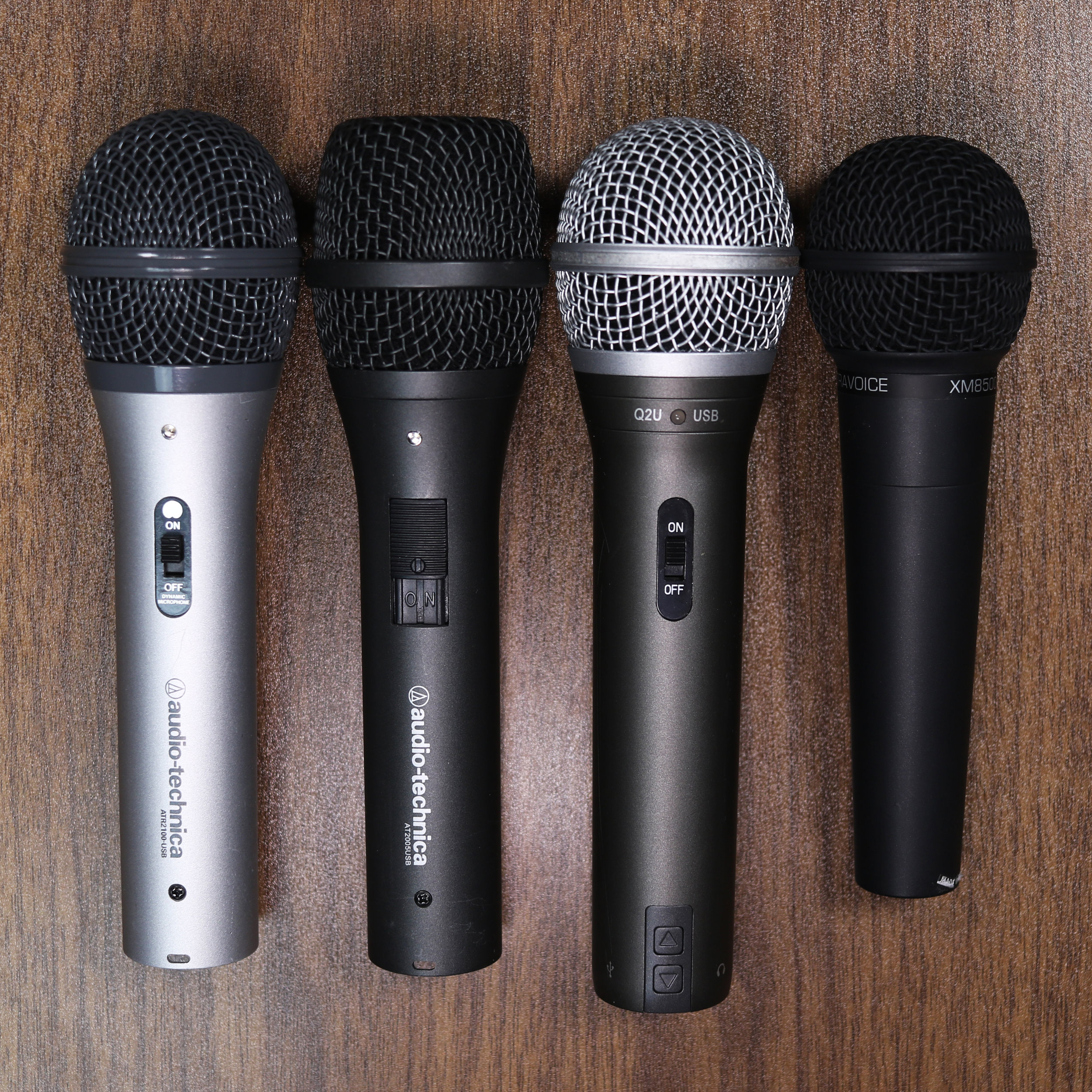12 Best Podcast Microphones of 2020
I want to start by stating that this article is purely subjective. These are the microphones that I personally think are the best options. There is no such thing as the “best” microphone because there are many factors that need to be accounted for when selecting a microphone.
This article will provide you my picks of the best podcast microphones to start a show with. This list is compiled completely of microphones I have actually used, tested and reviewed. In order to avoid just telling you what to buy, I figured I would provide sound samples and a playlist of reviews to allow you to make up your own mind about which mic is right for you. If you would like more information on selecting different styles of microphones, you can check out my article How To Find the Right Microphone.
Before we get into the list, there are some notes that I would like to discuss.
Dynamic vs. Condensers
Simply put, this indicates if a microphone requires phantom power or not. A dynamic microphone does not require phantom power, but a condenser microphone does. You will find that on this list, the majority of microphones are dynamic. I have made this decision because dynamic mics typically pick up less ambient noise. This is important if you are recording in a non-treated room or if you’re in a studio where you’re positioned near another host. Let me know on twitter @bandrewsays if you would like me to make an article about my theories as to why Dynamics are better at rejecting background noise.
USB vs. XLR
This indicates how you will be connecting the microphone to your computer. USB microphones connect to your computer with a USB cable, and that’s it. Once you start getting into live processing of your audio or if you’re recording multiple microphones onto the same computer, this can become a limitation, and that’s why I have included only USB mics that include an XLR output as well.
XLR microphones on the other hand require an XLR to XLR cable and a USB audio interface. This makes the option potentially more expensive than the USB option, but it allows you more granularity in your set up. You can introduce outboard gear like a DBX286s or Neve 5017, and record multiple XLR mics much easier by using a USB Mixer or a multi-channel USB Audio Interface.
With those notes out of the way, here are my recommendations:
ENTRY LEVEL
Behringer XM8500
Buy this Mic: https://geni.us/xm8500
This mic is an absolute steal at the price. It sounds great, is built really well, and it’s dirt cheap. When I had to outfit a full conference with microphones, I used XM8500’s. If you’re looking for an XLR Dynamic to start with, and you’re on a budget, then this is what you want to go with.
Pros:
- Excellent performance for price
- Full bodied and crisp
Cons:
- Bad with plosives
Samson Q2u
Buy this Mic: https://geni.us/samq2u
This is likely my most recommended microphone when people ask for a starting recommendation. I simply don’t think it can be beaten for the price. It is an XLR & USB microphone, meaning you can connect it over USB to start out, and if you want to upgrade to include outboard gear or a USB audio interface, you can do so without upgrading.
Pros:
- Both XLR & USB connectivity
- Cheap for what you’re getting
Cons:
- Suffers from sibilance issues
Audio Technica ATR2100USB
Buy this Mic: https://geni.us/2100usb
This is another microphone that is both XLR & USB. It has a slightly different tone than the Samson Q2u, making it a little bit more nasally, but it suffers less from sibilance. If you prefer this tone to the q2u, and you’re willing to spend a few more dollars, it’s absolutely worth it.
Pros:
- Both XLR & USB connectivity
Cons:
- A bit nasally sounding
- A little lacking in the low end
Audio Technica AT2005USB
Buy this: https://geni.us/at2005usb
To my ears, and based on the specs, this mic appears to be and sounds to be the exact same as the slightly cheaper ATR2100USB. However, it looks a lot cooler. If you care how the mic looks and you like the tone of the ATR2100USB, then this is the option for you.
Pros:
- Both XLR & USB connectivity
- Smoother on/off switch compared to the 2100usb.
Cons:
- A bit nasally sounding
- A little lacking in the low end
- Same sound as 2100usb, but more expensive
LEAST FAVORITE OPTION
Any Mic Connected to Your Computers Motherboard
This is quite a broad group of microphones that I am lumping in here. You can get a Neewer NW700 or BM800 or Pyle PDMIC58, and they can sound pretty good if you connect them to an audio interface.
However, a lot of people connect these budget mics direct to their motherboards 3.5mm microphone input. The reason this is bad is because the budget microphones are not the best to begin with, but also you are running an entry level microphone through your motherboards microphone preamp and analog to digital converter which are typically some of the worst you can find. You may also find some digital interference in your recording do to the microphone input picking up noise from the other components that are near it on the motherboard.
MID TIER
Shure SM58
Buy this Mic: https://geni.us/sm58
This is the most famous microphone of all time. Just look on any stage and you’ll likely see the SM58. The microphone has a classic sound if not a little dark compared to many modern microphones. Also, this microphone is built so well that it will likely outlive you.
Pros:
- Built like an absolute tank
Cons:
- A bit mid forward / nasally
Sennheiser E835
Buy this Mic: https://geni.us/e835
The E835 is a much brighter more “condenser” like dynamic microphone. I would venture to say that it may be a bit too bright if you have a higher pitched voice like myself, but if you have a deeper voice, or you need to ensure a LOT of detail and clarity, this is a GREAT option.
Pros:
- Plenty of clarity
Cons:
- A bit top heavy, with a little bit of “sizzle” in the upper range.
sE Electronics V7
Buy this Mic: https://geni.us/sEv7
This is a great amalgamation of two other microphones in this “mid tier”. It has the super cardioid polar pattern of the Beta 58a, and the brightness of the E835. The high end on this mic is much more tame than the 835, meaning if you have a brighter voice it won’t be as jarring to listen to. If you’re looking for slightly better rejection from the sides, with a little more clarity and detail, then this is a GREAT option.
Pros:
- Plenty of clarity in the top end, but not top heavy.
- Super cardioid polar pattern increases rejection.
Cons:
- Suffers a LITTLE bit from sibilance
Shure Beta 58a
Buy this Mic: https://geni.us/beta58a
The beta 58a is a great alternative to the SM58. This has a super cardioid polar pattern meaning it will do better at rejecting noise from the sides, and it has a slight extension in the high end when compared to the 58. If you’re looking for that classic SM58 tone but with a little more oomph in the high end and a little more rejection, this is the mic for you.
Pros:
- More detail in the top end compared to the SM58
- Super cardioid polar pattern increases rejection.
- Incredible build quality
Cons:
- More expensive than the 58
LEAST FAVORITE OPTION
Blue Yeti
This microphone is not technically bad, but I have not seen a microphone that has led to more bad audio than the yeti. I believe the reason for this is the stand it comes with and the multiple polar patterns. People end up setting it on omni directional by accident which ends up picking up far too much ambient noise, OR they have it 2-3 feet away from their mouth and it picks up far too much ambient noise. You can make this mic sound good, but I think most people misuse it and unless you need multiple polar patterns, it should be avoided.
PROFESSIONAL
Audio Technica AT875R
Buy this Mic: https://geni.us/at875r
This is a shotgun microphone (the type of microphone typically used on a movie), meaning it does very good at rejecting sounds from the side. If you use this microphone between 3 to 6 inches from your mouth with a pop filter, you can get a very crisp and full sound.
Pros:
- Excellent off axis rejection
- Very detailed and clear sound
Cons:
- High self noise of ~20dB
Beyerdynamic M201TG
Buy this Mic: https://geni.us/M201
The 201TG is a sleeper microphone that doesn’t get the love it deserves even though it’s used in some BBC Radio Stations. This microphone has a lot of clarity, but remains un harsh, and the proximity effect on this thing can really be used to beefen up your voice if it’s somewhat thin. You may end up needing to roll off some of the low end though.
Pros:
- Very smooth proximity effect
- Nice clarity in the top without sounding harsh
Cons:
- Not good with plosives as it is an instrument mic.
Shure SM7b
Buy this: https://geni.us/shuresm7b
The Sm7b is likely my all time favorite microphone. It has a very smooth tone that some may consider dark. If it’s a bit too dark, it does have the ability to activate a low cut switch to remove some of the low end or the presence boost switch to brighten it up. It does require a LOT of gain though, so you need to make sure your interface/preamp has enough gain to drive this mic.
Pros:
- Extremely smooth tone
- Proximity effect is not overpowering
- Versatile with presence boost & high pass filter switches.
Cons:
- Needs ~60dB of gain!
- May be a bit dark for some preferences.
Electro Voice RE20
Buy this Mic: https://geni.us/re20
The RE20 is another broadcast standard and it’s apparent why. It is much brighter with a lot more clarity compared to a mic like the SM7b. However, it can be a little bit sibilant and sound a bit scooped in the mids, but it’s still an amazing sounding microphone. It requires slightly less gain than the SM7b but it is still pretty gain hungry.
Pros:
- Very crisp sound for a dynamic
- Variable-D technology limits proximity effect
Cons:
- Suffers from some sibilance
- Needs ~56.5dB of gain
LEAST FAVORITE OPTION
Rode Podcaster
I’m not sure how it happened because the Rode Procaster sounds great, but somehow they made the podcaster sound awful. I compared all usb dynamic mics that I had a while back, and this ended up at the bottom of the list because of how thin it sounds. It’s almost as though there is a 300Hz high pass on the mic. There is apparently a 2nd version of this microphone, but there is no information about this update that I can find anywhere.




